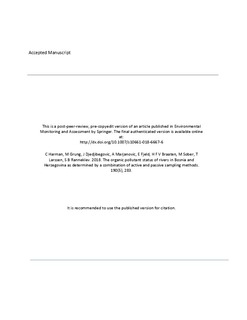| dc.contributor.author | Harman, Christopher | |
| dc.contributor.author | Grung, Merete | |
| dc.contributor.author | Djedjibegovic, Jasmina | |
| dc.contributor.author | Marjanovic, Aleksandra | |
| dc.contributor.author | Fjeld, Eirik | |
| dc.contributor.author | Braaten, Hans Fredrik Veiteberg | |
| dc.contributor.author | Sober, Miroslav | |
| dc.contributor.author | Larssen, Thorjørn | |
| dc.contributor.author | Ranneklev, Sissel Brit | |
| dc.date.accessioned | 2019-06-03T08:02:49Z | |
| dc.date.available | 2019-06-03T08:02:49Z | |
| dc.date.created | 2019-01-28T10:59:16Z | |
| dc.date.issued | 2018 | |
| dc.identifier.citation | Environmental Monitoring & Assessment. 2018, 190 (5). | nb_NO |
| dc.identifier.issn | 0167-6369 | |
| dc.identifier.uri | http://hdl.handle.net/11250/2599623 | |
| dc.description.abstract | There is an overall lack of data concerning the pollution status of Bosnia Herzegovina, which is confounded by fragmented national environmental management. The present study aimed to provide some initial data for concentrations of priority substances in two major Bosnian Rivers, using two types of passive sampler (PS) as well as by using high volume water sampling (HVWS). Overall, concentrations of most persistent organic pollutants (POPs), including polychlorinated biphenyls (PCBs) and legacy pesticides, were shown to be low. However, around the town of Doboj on the Bosna River, concentrations of polycyclic aromatic hydrocarbons (PAH) breached European standards for several compounds and reached 67 ng L−1 for freely dissolved concentrations and 250 ng L−1 for total concentrations. In general, contamination was lower in the Neretva River compared to the Bosna, although for brominated diphenyl ethers (PBDEs), results suggested an active source of PBDEs at one location based on the ratio of congeners 47 and 99. Direct comparisons between the different sampling techniques used are not straightforward, but similar patterns of PAH contamination were shown by HVWS and PS in the Bosna River. There are both scientific and practical considerations when choosing which type of sampling technique to apply, and this should be decided based on the goals of each individual study. | nb_NO |
| dc.language.iso | eng | nb_NO |
| dc.publisher | Springer | nb_NO |
| dc.title | The organic pollutant status of rivers in Bosnia and Herzegovina as determined by a combination of active and passive sampling methods | nb_NO |
| dc.type | Journal article | nb_NO |
| dc.type | Peer reviewed | nb_NO |
| dc.description.version | acceptedVersion | nb_NO |
| dc.source.pagenumber | 10 | nb_NO |
| dc.source.volume | 190 | nb_NO |
| dc.source.journal | Environmental Monitoring & Assessment | nb_NO |
| dc.source.issue | 5 | nb_NO |
| dc.identifier.doi | 10.1007/s10661-018-6667-6 | |
| dc.identifier.cristin | 1666037 | |
| cristin.unitcode | 7464,20,12,0 | |
| cristin.unitcode | 7464,30,12,0 | |
| cristin.unitcode | 7464,30,0,0 | |
| cristin.unitcode | 7464,20,19,0 | |
| cristin.unitname | Marin forurensning | |
| cristin.unitname | Akvatiske miljøgifter | |
| cristin.unitname | Fagsenter for ferskvannsmiljø | |
| cristin.unitname | Miljøgifter | |
| cristin.ispublished | true | |
| cristin.fulltext | postprint | |
| cristin.qualitycode | 1 | |
